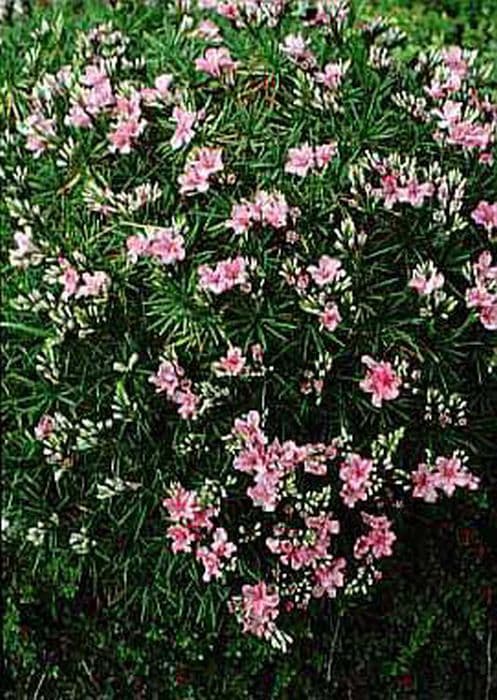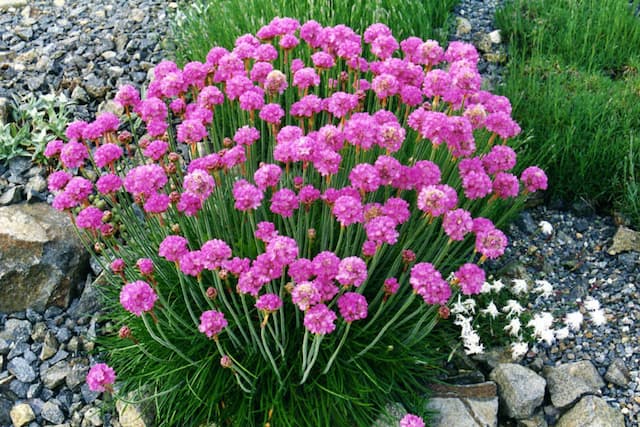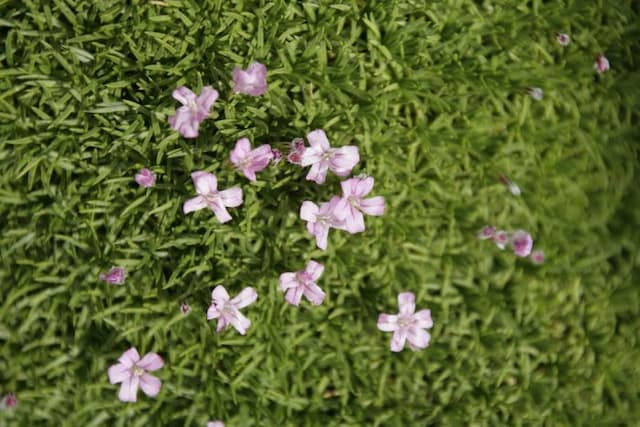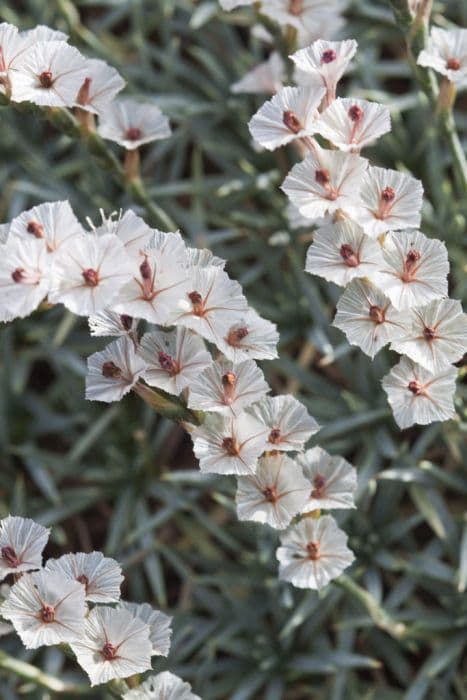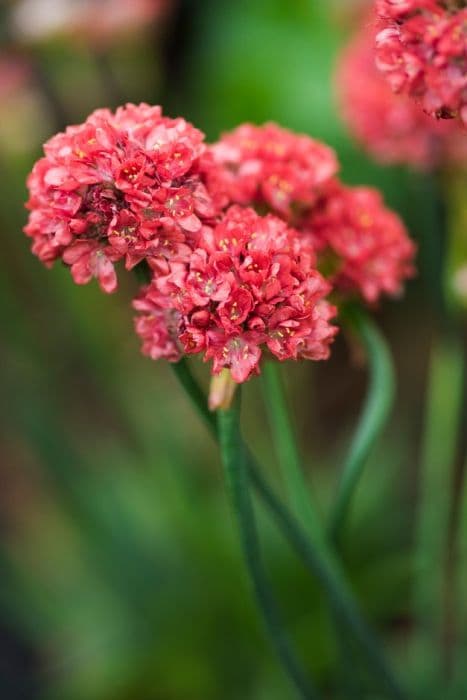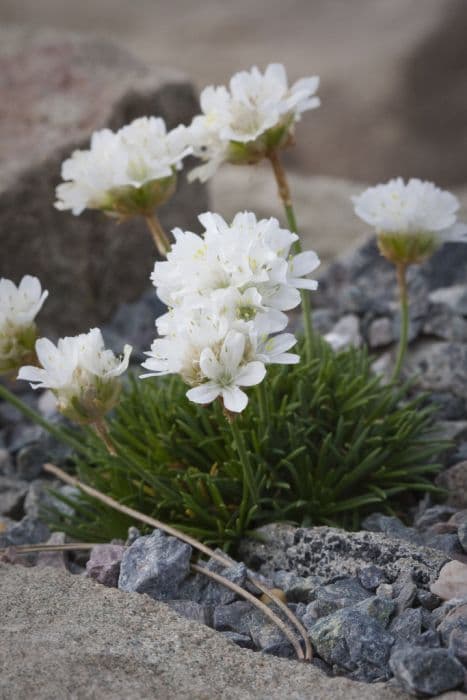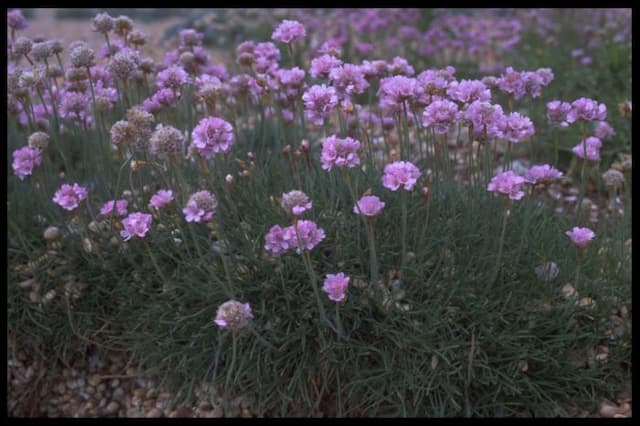Chinese plumbago Ceratostigma willmottianum Sapphire Ring = 'Lissbrill' (PBR)

ABOUT
The Ceratostigma willmottianum Sapphire Ring, commonly known as Plumbago or Leadwort, features striking blue flowers that distinctly contrast with its lush green foliage. The blooms are vivid and sapphire-like, resembling little gems adorning the plant. They are typically intense in color and have a tubular shape, which collectively create a vibrant and eye-catching display during its flowering season. The leaves of the Plumbago are also noteworthy. They have a glossy texture and can exhibit a somewhat leathery appearance. The foliage often takes on a beautiful reddish tinge as the seasons progress into colder temperatures, adding another layer of visual interest to this already attractive plant. The plant's overall form is bushy and compact, making it a suitable candidate for various garden settings where it can serve as a colorful highlight. Moreover, the Plumbago is known to attract pollinators such as butterflies, adding a dynamic element of wildlife to its surroundings. The radiant blue of the flowers in conjunction with the shifting hues of the leaves ensures that the Plumbago remains a stunning addition to any garden throughout its growing season.
About this plant
 Names
NamesFamily
Plumbaginaceae
Synonyms
Chinese Plumbago, Hardy Blue-flowered Leadwort
Common names
Ceratostigma willmottianum Sapphire Ring = 'Lissbrill' (PBR).
 Toxicity
ToxicityTo humans
Plumbago, as Ceratostigma willmottianum is commonly known, is not typically considered toxic to humans. There are no commonly reported symptoms of poisoning because it is generally not known to be a poisonous plant. Ingesting any part of this plant should not lead to significant consequences, but it is always advised to avoid consumption of ornamental plants.
To pets
Plumbago is not known to be toxic to pets either. Similar to its effects on humans, there are no well-documented symptoms of poisoning from this plant. Ingestion of the plant by pets usually does not lead to serious health issues. Nonetheless, it's always best to prevent pets from eating plants as a precautionary measure.
 Characteristics
CharacteristicsLife cycle
Perennials
Foliage type
Deciduous
Color of leaves
Green
Flower color
Blue
Height
3 feet (0.91 meters)
Spread
3 feet (0.91 meters)
Plant type
Shrub
Hardiness zones
6
Native area
China
Benefits
 General Benefits
General Benefits- Hardy Perennial: Survives in temperate climates across multiple growing seasons.
- Bright Blue Flowers: Produces vivid, attractive blue flowers that enhance garden aesthetics.
- Low Maintenance: Requires minimal care compared to many other ornamental plants.
- Drought Tolerant: Capable of withstanding periods without water once established.
- Attracts Wildlife: Flowers can attract pollinators like bees and butterflies to the garden.
- Suitable for Containers: Can be grown in pots, making it versatile for patios and balconies.
- Seasonal Color Change: Foliage turns to stunning red or burgundy shades in autumn, offering seasonal interest.
- Compact Growth: Well-suited for small gardens or spaces due to its compact size.
- Deer Resistant: Less prone to be eaten by deer, which helps to keep the garden intact.
- Easy to Propagate: Can be easily propagated from cuttings, allowing gardeners to expand their plant collection.
- Soil Versatility: Adapts to a range of soil types, though it prefers well-drained conditions.
 Medical Properties
Medical PropertiesThis plant is not used for medical purposes.
 Air-purifying Qualities
Air-purifying QualitiesThis plant is not specifically known for air purifying qualities.
 Other Uses
Other Uses- Ceratostigma willmottianum Sapphire Ring can be incorporated into themed gardens such as a blue and white garden due to its bright blue flowers that can complement white blooms or silver foliage.
- The intense blue flowers of the plant can be used in designing a monochromatic landscape, especially to create a calming, serene garden space.
- Dwarf Plumbago can be utilized in a rock garden, thriving in well-draining soil and adding a pop of color among the rocks and alpine plants.
- The plant's ability to contrast with autumnal orange and yellow tones makes it ideal for foliage-themed garden designs.
- Its low-growing and spreading habit allows it to be used as a living mulch, suppressing weeds while adding aesthetic value to garden beds.
- The ground-covering nature of Dwarf Plumbago can be employed to stabilize soil on slopes or in erosion-prone areas with its root system.
- Ceratostigma willmottianum Sapphire Ring can be planted in containers for patios or balconies where its vibrant flowers can add seasonal interest.
- The dried flowers of Dwarf Plumbago can be used for creating natural, delicate bookmarks by pressing them into heavy books.
- It can be used in educational botanical gardens as a specimen to demonstrate the evolution of plumbaginaceae family and flower structure.
- During festive seasons, fresh or dried branches of Dwarf Plumbago can be used for crafting unique and colorful wreaths or other decorative items.
Interesting Facts
 Feng Shui
Feng ShuiThe Chinese plumbago is not used in Feng Shui practice.
 Zodiac Sign Compitability
Zodiac Sign CompitabilityThe Chinese plumbago is not used in astrology practice.
 Plant Symbolism
Plant Symbolism- Persistence: Ceratostigma, commonly known as "Plumbago", is known for its resilience and ability to thrive in various conditions, symbolizing the ability to persist through adversity.
- Transformation: Plumbago undergoes a stunning seasonal transformation with its leaves changing color in the fall, representing change and the beauty of life cycles.
- Healing: Traditionally, plumbago has been associated with healing due to its use in herbal medicine, thus symbolizing restoration and wellbeing.
- Faithfulness: With its true blue flowers, plumbago is often associated with fidelity and steadfastness in relationships.
 Water
WaterThe Chinese Plumbago should be watered deeply and thoroughly when the top inch of soil feels dry to the touch. During the growing season, this may mean watering once or twice a week, depending on weather conditions. Ensure that the plant receives about 1 gallon of water per session, allowing the moisture to penetrate the root zone. In the winter, reduce watering to every few weeks to prevent overwatering as the plant's growth slows down. Always check the soil moisture level before adding water to avoid waterlogging.
 Light
LightThe Chinese Plumbago thrives in full sun to partial shade. For best flowering, place the plant in a spot where it can receive at least 6 hours of sunlight daily. If planted in too much shade, the plant may produce fewer flowers and have a leggier growth habit.
 Temperature
TemperatureThe Chinese Plumbago is hardy and can tolerate temperatures as low as 0 degrees Fahrenheit, but it thrives when the temperatures are between 60 and 75 degrees Fahrenheit. To protect the plant from extreme cold, provide mulch or cover when temperatures drop significantly below freezing.
 Pruning
PruningPrune the Chinese Plumbago in the late winter or early spring to maintain its shape and encourage bushier growth. Remove any dead or damaged branches, and cut back last year's growth to promote new flowers. Pruning can be done annually or as needed to keep the plant looking tidy.
 Cleaning
CleaningAs needed
 Soil
SoilThe Plumbago or Leadwort (Ceratostigma willmottianum 'Sapphire Ring') thrives in a well-draining, loamy or sandy soil mix with a slightly acidic to neutral pH of around 6.0 to 7.5. A mixture of two-thirds loam and one-third sand or compost is ideal to ensure proper drainage and fertility. It is important to avoid heavy, water-logged soils to prevent root rot. Regular organic matter addition can help maintain soil health.
 Repotting
RepottingPlumbago, or Leadwort, should generally be repotted every 2-3 years to refresh the soil and provide room for growth. It's best repotted in the spring just before the growing season begins. When repotting, choose a container that is one size larger than the current one to allow for root expansion.
 Humidity & Misting
Humidity & MistingPlumbago, or Leadwort, is adaptable to a wide range of humidity levels but prefers moderate humidity. It does not require unusually high humidity environments and can thrive in the average atmospheric humidity found in most temperate climates. Ensure good air circulation to prevent fungal issues.
 Suitable locations
Suitable locationsIndoor
Ensure bright indirect light, well-draining soil, and moderate watering.
Outdoor
Full sun to partial shade, well-drained soil, space 2 feet apart.
Hardiness zone
6-9 USDA
 Life cycle
Life cycleCeratostigma willmottianum Sapphire Ring, commonly known as Plumbago, begins its life cycle as a seed, which upon finding favorable conditions, germinates and give rise to a small seedling. As the seedling matures, it develops into a young plant with a rosette of leaves close to the ground, and eventually forms a woody, shrub-like structure with multiple stems. Through the growing season, Plumbago produces rich, blue to violet flowers that are highly attractive to pollinators. After pollination, these flowers then develop into small fruit that contain seeds, thus completing the reproductive stage of its life cycle. In regions with cold winters, Plumbago enters a period of dormancy, losing its leaves and ceasing growth until favorable conditions return in spring. In its native habitat or suitably warm climates, the plant may remain evergreen and continue growth throughout the year.
 Propogation
PropogationPropogation time
Late summer
The most popular method of propagating Ceratostigma willmottianum 'Sapphire Ring' is through softwood cuttings. This is usually done in late spring or early summer, when new growth is tender and green. Gardeners select healthy, non-flowering shoots and make a cutting about 4 to 6 inches long (10 to 15 cm), just below a leaf node. The lower leaves are removed, and the cut end can be dipped in rooting hormone powder to encourage root development. The cutting should then be placed in a well-draining soil mix and kept in a bright area without direct sunlight. Maintaining consistent moisture without waterlogging is key to successful rooting. Roots generally develop within a few weeks, and once established, the new plant can be gradually acclimatized to outdoor conditions before planting in its final location.
